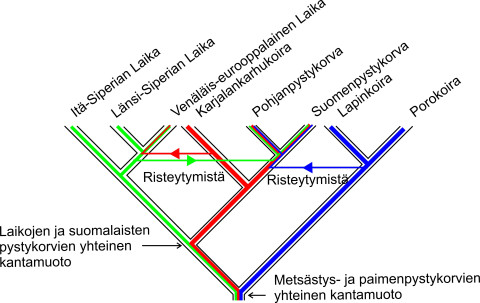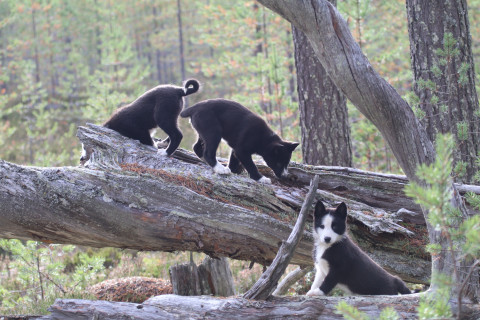Traditional Finnish hunting dogs are represented by three contemporary Spitz breeds: the Karelian Bear Dog, the Finnish Spitz and the Nordic (or Norrbotten’s) Spitz. Although the Nordic Spitz is registered to Sweden, it originates from ethnically Finnish cultural region spanning from northern Sweden to White Sea Karelia.
The Karelian Bear Dog, the Finnish Spitz and the Nordic Spitz are known to be uniquely Finnish, but their evolutionary history as well as their relationship to the other breeds in the adjacent regions has been unclear. Now a recent study from the University of Eastern Finland and Genoscoper Laboratories Ltd has revealed that these three Spitz breeds form their own genealogical branch, whose closest relatives are the eastern Eurasian Laika breeds. In contrast, the Scandinavian Spitz breeds belong to the Western European breeds, which differ markedly from the Finnish breeds despite their geographical proximity. Admixture of reindeer herding breeds into the ancestors of the Finnish and the Nordic Spitz but not the Karelian Bear Dogs complicates their family tree, as does the admixture of Finnish Hound to all three breeds.
The study also addressed the genetic differentiation within and between the breeds. The Finnish and the Nordic Spitz are practically sister breeds, with the Finnish Spitz being genetically more differentiated compared to the ancestral population than the Nordic Spitz. This is likely due the differences in the breeding histories of the two breeds. No subpopulation differentiation was detected among the Finnish hunting Spitz breeds, but the reindeer herding Lapphound seems to be gradually differentiating into show and working lineages.
The Karelian Bear Dog, the Finnish Spitz and the Nordic Spitz are the surviving representatives of the hunting dogs that had developed in the eastern Fennoscandia during the last millennia, and great care should be taken to preserve them also for the future generations. The published work is the first of its kind regarding the origins of Finnish hunting dog breeds and is also a tribute to the 80th anniversary of the Finnish Spitz Club.
The original study published in PLoS ONE is freely accessible at:
http://journals.plos.org/plosone/article?id=10.1371/journal.pone.0199992
For more information, please contact:
Dr Jaakko Pohjoismäki, University of Eastern Finland, Department of Environmental and Biological Sciences, tel. +358 50 5744745, email. [email protected]
Photo 1: Karelian Bear Dog puppies. Photo by Heikki Manninen.
Photo 2: Figure represents the family tree of the Finnish Spitz breeds. Admixture between populations is a frequent event in the dog breed histories and complicates research. Fortunately, the modern computational methods make it possible to identify the admixture events from the dog genomes. The contemporary Finnish and Nordic Spitz show ancestral admixture with reindeer herding breeds as well as with western Siberian Laika (like) breed. Note also the influence of Karelian Bear Dog in the ancestry of Russo-European Laika.


